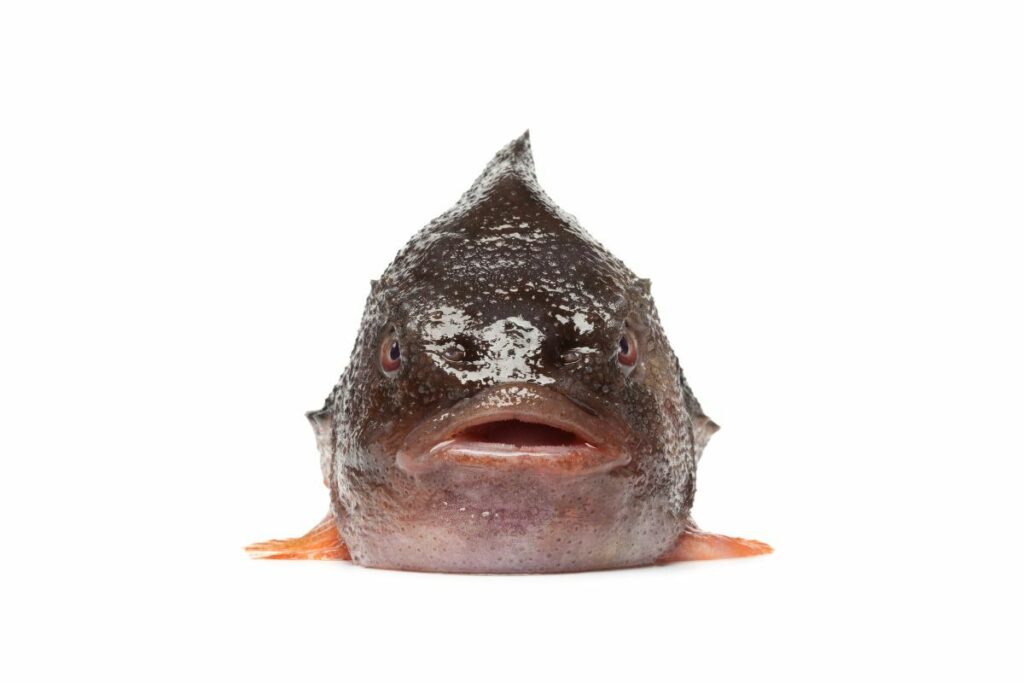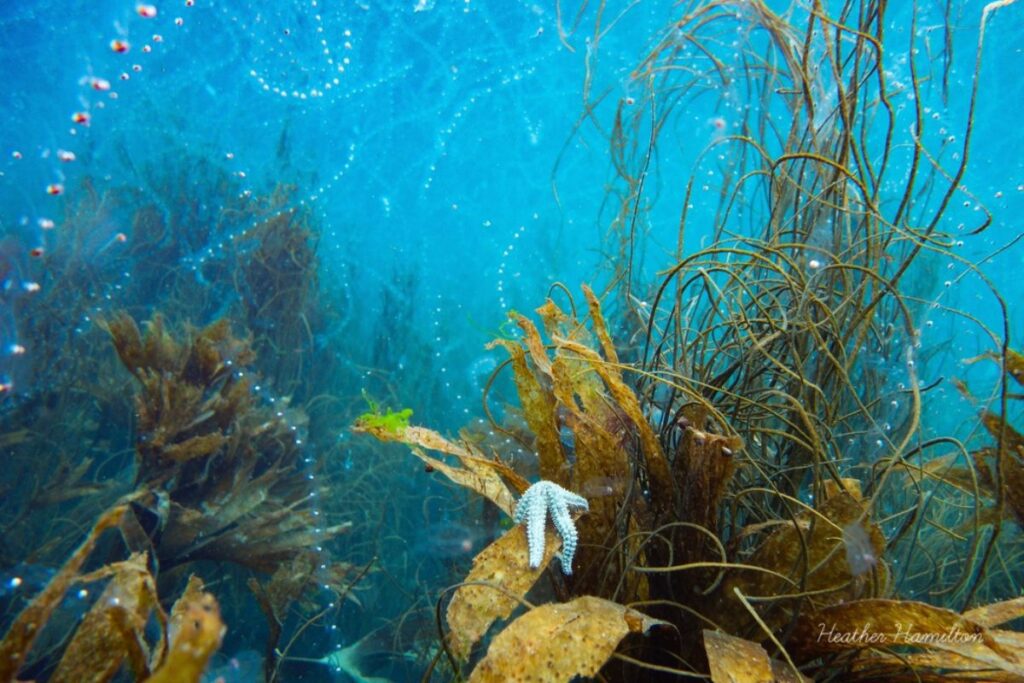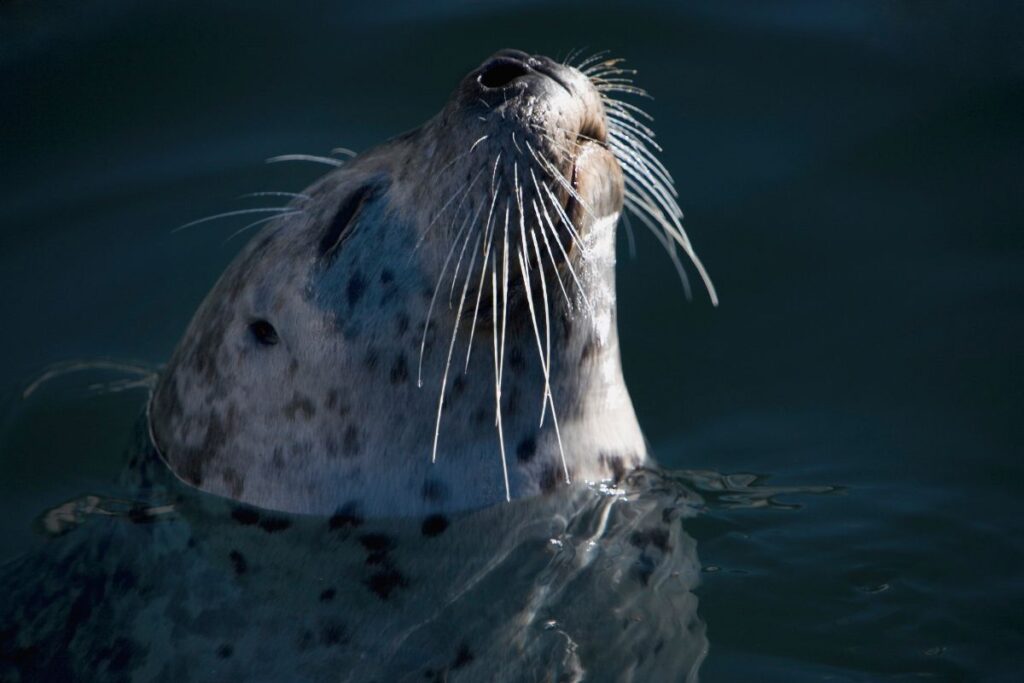Why choose winter for wildlife spotting?
Wildlife watching isn’t just restricted to warmer months – winter can provide a beautiful backdrop to experience some wonderful wildlife encounters around Cornwall. With fewer crowds, and less boats on the water, winter is a fantastic opportunity to spot some of the marine species that we see around the coast during this time of year. Some species are unique to Cornwall during the winter, meaning it can also be a chance to spot something different to the other seasons.
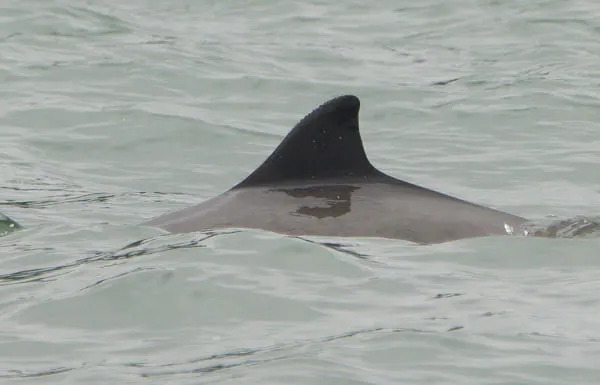
Top winter wildlife to spot in Cornwall
Rare sightings
Humpback whales are becoming an increasingly sighted marine mammal around the Cornish coastline between November and March. However, it should be noted that these sightings are still sporadic. Over the past few winters, humpback whales have been spotted in numerous areas including Padstow Bay, Mounts Bay, and Falmouth Bay to name a few.
Some of the individuals have been seen on multiple occasions. We know this because of distinctive marks or scars on the whales fluke, pigmentation on the body, and the shape of the dorsal fin. Increased sightings are likely due to increased public awareness, and recovery of the Atlantic population after historic whaling activity, though the exact reason is still unknown.
Seal pups
Atlantic grey seals pup and breed during the winter months, meaning more time is spent close to land and hauled out. Adult males (bulls) will claim a territory before the adult females (cows) arrive at the same site each year to give birth. The pupping season varies in the UK depending on the location. In Cornwall, pups are generally born from August to November so it is not uncommon to see furry white pups dotted along the coastline during this time.
Though wonderful to see, it is important to remember that grey seals should always be observed from a distance, minimising disturbance risk. Grey seal pups only spend three weeks with their mum feeding on her milk, meaning this time is crucial for the survival of the pup. Once the nursing period is over, females will then mate with a dominant male.
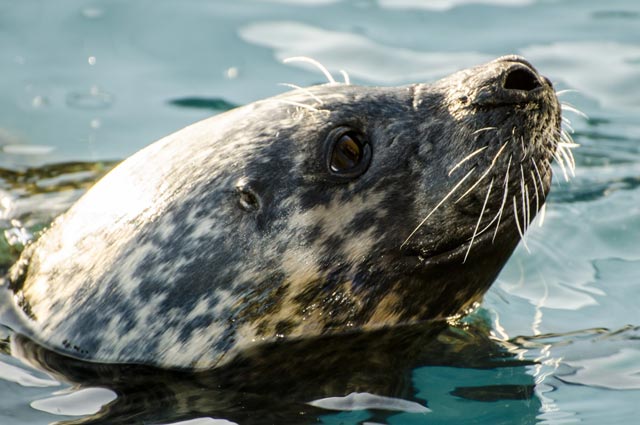
Common dolphins
Common dolphins can be seen around the Cornish coastline throughout the year. As a highly transient species, common dolphins are frequently spotted in Padstow Bay when moving inshore for feeding opportunities. Easily identifiable from the distinctive yellow and grey hourglass pattern along their body, these sociable animals often interact with boats, resulting in a wonderful winter wildlife experience for those on board.
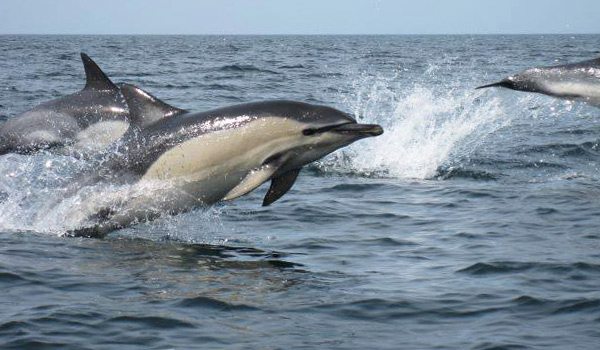
Bottlenose dolphins
Bottlenose dolphins can also be spotted around the coastline year-round. Much larger in size than the commons, bottlenose dolphins can reach 4 metres in length and 500 kilograms in weight. Bottlenose dolphins are grey in colour, darker on top, and paler underneath, with a short, stubby beak resembling the shape of a bottle.
There are two genetically distinct ecotypes: coastal and offshore. As the name suggests, offshore bottlenose dolphins prefer cooler water and are found further from the coast. Coastal bottlenose dolphins tend to be found in bays, estuaries and shallower water bodies. In the south of England there is a resident pod of coastal bottlenose dolphins that range from Kent to the north Cornish coast, so there is always a possibility of a sighting around Cornwall.
Bird species
Certain bird species can be found around the Cornish coastline throughout all seasons. The tall, slender shape of the Cormorant is commonly found, with the UK holding internationally important wintering numbers of the species. Similar in its appearance, the European shag is another familiar sight. Both species can be seen perched on rocks with their wings held outstretched to dry their soaked feathers after diving.
Fulmar are found at sea outside of their Spring breeding season, in search of food. It is thought that the UK is home to around 1.7 million wintering fulmar each year. This gull-like, grey and white bird is part of the ‘tubenose’ family, and is a close relative of the Albatross.
Best locations for Winter wildlife spotting?
Padstow and the Camel Estuary
Padstow Bay and the Camel Estuary is a fantastic spot for some winter wildlife watching. Whether you join us on an exhilarating boat trip, observe from the coast path at The Rumps, or take a walk on the Camel Trail with your binoculars, you’ll be sure to fall in love with the rugged coastline of the bay, along with the estuarine and marine life present.
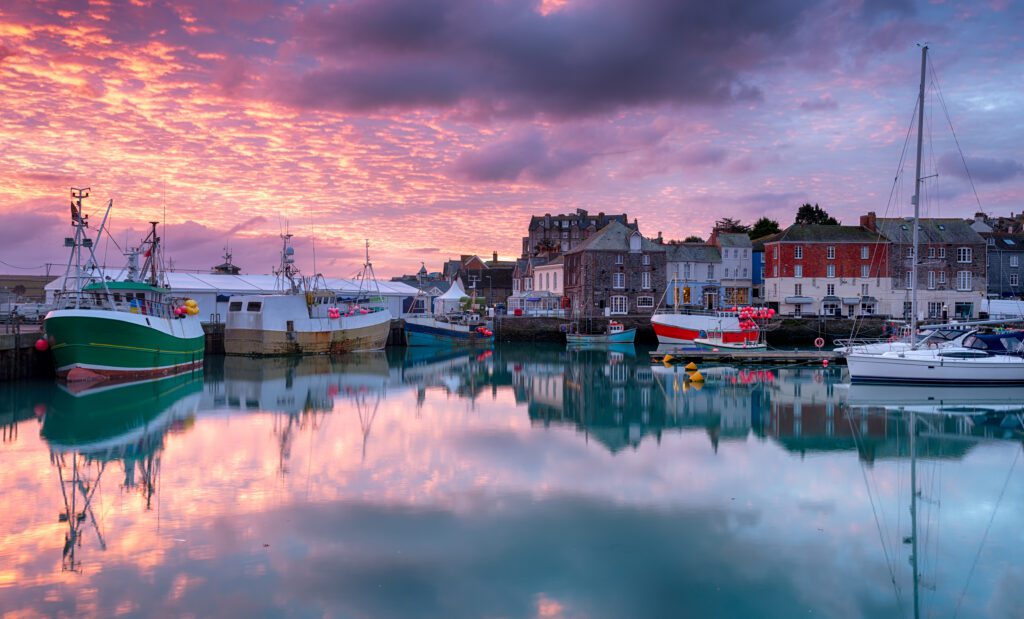
Species regularly seen in the winter include grey seals, common dolphins, bottlenose dolphins, guillemots, northern gannets and many more!
The Lizard Peninsula
At England’s most southerly point, The Lizard is remote and exposed to the elements. Wandering out on the Lizard peninsula comes with the benefit of a 280 degree panoramic view, perfect for trying to spot wildlife. Some of the most commonly spotted species in the area include grey seals hauled out on rocks, or sheltering in the coastal waters on a calm day.
Land’s End
As an ‘Area of Outstanding Natural Beauty’, Land’s End is a biodiversity hotspot and hosts spectacular views of Longships Lighthouse. From the 200 ft high granite cliffs, a variety of species can be seen including grey seals, dolphins, northern gannets, and fulmars.
Padstow Sealife Safaris winter tours.
What to expect on our winter trips?
During a winter trip with Padstow Sealife Safaris, you can expect a high-speed, thrilling experience to see the dramatic coastline around Padstow, and hopefully some of the rich and diverse marine life. Of course we can never guarantee sightings, as we are searching for wild animals, but we have knowledgeable skippers and wildlife guides who are very experienced in searching for wildlife.
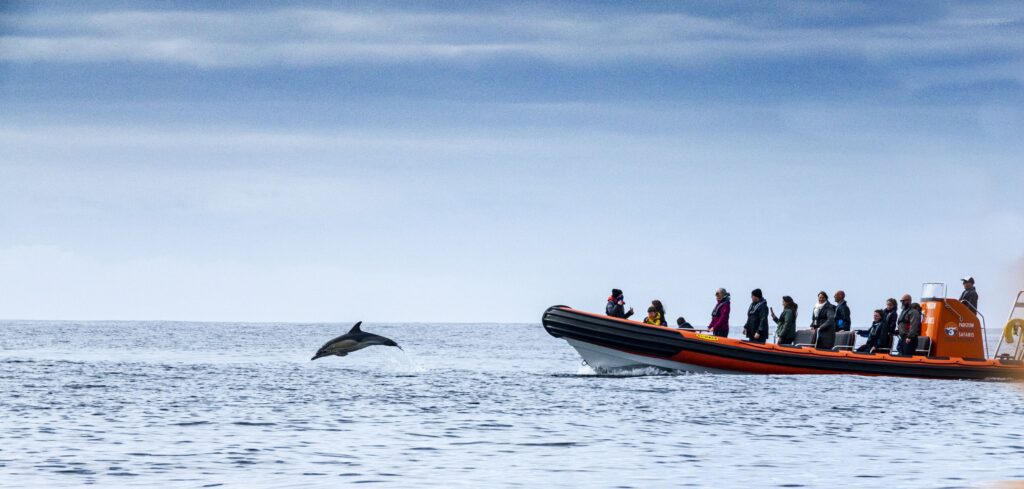
Safety and comfort measures
Your safety and comfort is our crew’s priority. When you check-in for your trip, you will be provided with a waterproof jacket and pair of trousers, along with a lifejacket. We would recommend wearing lots of layers to ensure you stay warm on your trip! If you have waterproof layers, you are welcome to bring your own. Fleeces, gloves, hats, scarves, sunglasses, and suitable grippy footwear are also advised. It is also a good idea to bring binoculars if you have them, for the best views of seals and seabirds.
Best times of day for wildlife spotting
For most species that we see on our trips, there isn’t a better time of day to try and spot them. Common dolphins can be seen throughout the day, at different states of the tide. Grey seals can also be spotted throughout the day, but their haul-out behaviour is determined by the tide. We tend to see more seals hauled out on land between mid and low tide, then in the water to feed and travel at high tide. Seabird species are also seen throughout the day.
Conservation and responsible wildlife watching.
Cornwall is a popular spot for tourism, and we are the first to recommend our unparalleled scenery and wildlife. Spending a vast amount of time at sea, we see first-hand the effects of tourism, both positive and negative. This is why we channel a huge amount of our resources into conserving the environment and local wildlife, for future generations.
Leaving wildlife as you found it is key with ecotourism. We understand that it is incredibly difficult to visit wildlife in its natural habitat and remain completely unnoticed, but we ensure that by keeping sensible speeds and distances when in the presence of wildlife, reading and responding to their behaviour, our impact on the marine life we are there to enjoy is kept to a minimum, avoiding disturbing them, or disrupting their natural behaviours. Education is another important factor of eco-tourism. Not only do we engage passengers with interesting facts about the animals we spot, but we explain threats affecting their populations, and small ways in which individuals can help.
How you can help protect Cornwall’s wildlife
There are plenty of ways that you can help Cornwall’s wildlife! Read about a range of volunteering initiatives by the Cornwall Wildlife Trust here:
At Sea | Cornwall Wildlife Trust
There are fun and worthwhile projects for people of all ages and abilities. Marine conservation volunteering in the UK is growing quickly, and you can get involved.
Conclusion
Though some consider winter as being a lifeless and quiet time of year, life still goes on. With grey seals spending more time on land during their pupping season, and common dolphins in coastal waters throughout the year, winter is a great time to get out and see what the Cornish coastline has to offer. So wrap up warm, take gloves, a hat, a flask of hot drink, and see the beauty of winter in Cornwall.
FAQs
Are you likely to see any wildlife on a safari during the winter?
There is a good chance of seeing wildlife on our trips through all seasons. Of course we can never 100% guarantee sightings, but we are generally quite lucky with grey seal, common dolphin, and seabird sightings.
What should I bring to be prepared for the cold?
Wrap up warm in lots of layers to keep you warm. Bring waterproof layers if you have them, if not you can borrow jackets and trousers from us. These are only thin waterproof layers, so we recommend wearing jumpers, fleeces, gloves, hats, and scarves – particularly in winter!
Do you still go out if it is raining?
Yes! We go out in a variety of weather conditions including rain. We don’t let a few raindrops stop us from having fun. As they say, “there’s no such thing as bad weather, only bad clothes”.
Do you run trips through the whole winter?
We tend to run trips until the end of December, often having a short break in January before returning in late February. After that we run through the year, so long as the sea conditions allow us to.
Do you get wet on trips in the winter?
There is a good chance of getting wet on our trips throughout the year, not just in winter. Occasionally we are lucky and have a perfectly flat-calm day, but these are few and far between.
